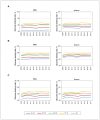Trends in glucose testing among individuals without diabetes in Ontario between 2010 and 2017: a population-based cohort study
- PMID: 35998927
- PMCID: PMC9402266
- DOI: 10.9778/cmajo.20210195
Trends in glucose testing among individuals without diabetes in Ontario between 2010 and 2017: a population-based cohort study
Abstract
Background: Early identification of people with diabetes or prediabetes enables greater opportunities for glycemic control and management strategies to prevent related complications. To identify gaps in screening for these conditions, we examined population trends in receipt of timely glucose testing overall and in specific clinical subgroups.
Methods: Using linked administrative databases, we conducted a retrospective cohort study of people aged 40 years and older without diabetes at baseline. Our primary outcome was up-to-date glucose testing, defined as having received testing at least once in the 3 years before each index year from 2010 to 2017, using linked administrative databases of people residing in Ontario, Canada. We calculated rates of up-to-date testing by age group, sex, ethnicity (South Asian, Chinese, general population) and comorbidities (hypertension, hyperlipidemia, cardiovascular disease).
Results: Over the 8-year study period, up-to-date glucose testing rates were stable at 67% for men and 77% for women (both relative risk 1.00 per year; 95% confidence interval 1.00-1.00). Testing rates were significantly lower in men than in women (all age groups p < 0.001) and lower in younger than older age groups (except those aged ≥ 80 yr). South Asian people had the highest testing rates, although among people aged 70 years or older, testing was highest in the general population (p < 0.001). Among people with hypertension, hyperlipidemia and cardiovascular disease, annual testing rates were also stable, but only 58% overall among people with hypertension.
Interpretation: We found lower glucose testing rates in younger men and people with hypertension. Our findings reinforce the need for initiatives to increase awareness of glycemic testing.
© 2022 CMA Impact Inc. or its licensors.
Conflict of interest statement
Competing interests: Catherine Yu reports receiving research grants from the St. Michael’s Hospital Medical Services Association, St. Michael’s Hospital (Unity Health Toronto), the Ontario SPOR SUPPORT Unit and the Royal College of Physicians and Surgeons of Canada. Kim Connelly reports receiving research grants and payment for presentations from AstraZeneca, Servier, Boehringer Ingelheim, Eli Lilly, Novartis, Novo Nordisk and Merck. Dr. Connelly also reports serving on a Data Safety Monitoring Board or Advisory Board for AstraZeneca, Servier, Boehringer Ingelheim, Eli Lilly, Novartis, Novo Nordisk and Merck. Gillian Booth reports receiving grants or contracts from the Canadian Institutes of Health Research (CIHR), Juvenile Diabetes Research Foundation and the Thistledown Foundation. Karen Tu reports receiving payments (to institutions) from CIHR, St. Michael’s Hospital Foundation, The College of Family Physicians of Canada, Foundation for Advancing Family Medicine, Canadian Medical Association Foundation, North York General Hospital, Heart and Stroke Foundation of Canada, Heart and Stroke Foundation of Ontario, Department of Defense (United States), University of Toronto (Department of Family and Community Medicine), MaRS Innovation Fund, Canadian Dermatology Foundation, Canadian Rheumatology Association (Canadian Initiative for Outcomes in Rheumatology Care), PSI Foundation, Cancer Care Ontario, Toronto Rehabilitation Institute Chair Fund, University of Toronto Practice-Based Research Network, Arthritis Society, MS Society of Canada, The Canadian Vascular Network and the Ontario SPOR SUPPORT Unit Targeted IMPACT Award. Sheldon Tobe reports receiving a KMH clinic unrestricted grant and in-kind support for the Zero to Five study, and consulting fees from AstraZeneca (all paid to Sunnybrook Research Institute). Dr. Tobe also reports receiving payment from Amgen, Astra-Zeneca, Bristol Myers Squibb, Bayer, Boehringer Ingelheim, Janssen, Lilly, Novartis, Novo Nordisk, Pfizer and Sanofi Genzyme for the CHEPPLUS education program. Dr. Tobe has worked on a volunteer basis with the American Hypertension Specialists Certification Program. No other competing interests were declared.
Figures



Similar articles
-
Immigration Status and Sex Differences in Primary Cardiovascular Disease Prevention: A Retrospective Study of 5 Million Adults.J Am Heart Assoc. 2021 Nov 16;10(22):e022635. doi: 10.1161/JAHA.121.022635. Epub 2021 Nov 2. J Am Heart Assoc. 2021. PMID: 34726069 Free PMC article.
-
Trends in cardiovascular care and event rates among First Nations and other people with diabetes in Ontario, Canada, 1996-2015.CMAJ. 2019 Nov 25;191(47):E1291-E1298. doi: 10.1503/cmaj.190899. CMAJ. 2019. PMID: 31767704 Free PMC article.
-
Utilization of DXA Bone Mineral Densitometry in Ontario: An Evidence-Based Analysis.Ont Health Technol Assess Ser. 2006;6(20):1-180. Epub 2006 Nov 1. Ont Health Technol Assess Ser. 2006. PMID: 23074491 Free PMC article.
-
Temporal trends in cardiovascular disease risk factors among white, South Asian, Chinese and black groups in Ontario, Canada, 2001 to 2012: a population-based study.BMJ Open. 2015 Aug 10;5(8):e007232. doi: 10.1136/bmjopen-2014-007232. BMJ Open. 2015. PMID: 26260346 Free PMC article.
-
Comorbidity-stratified estimates of 30-day mortality risk by age for unvaccinated men and women with COVID-19: a population-based cohort study.BMC Public Health. 2023 Mar 13;23(1):482. doi: 10.1186/s12889-023-15386-4. BMC Public Health. 2023. PMID: 36915068 Free PMC article.
Cited by
-
Association of prior outpatient diabetes screening with cardiovascular events and mortality among people with incident diabetes: a population-based cohort study.Cardiovasc Diabetol. 2023 Aug 28;22(1):227. doi: 10.1186/s12933-023-01952-y. Cardiovasc Diabetol. 2023. PMID: 37641086 Free PMC article.
References
-
- Grundy SM, Benjamin IJ, Burke GL, et al. Diabetes and cardiovascular disease: a statement for healthcare professionals from the American Heart Association. Circulation. 1999;100:1134–46. - PubMed
-
- 2011 Diabetes in Canada 2011: facts and figures from a public health perspective. Ottawa: Public Health Agency of Canada; 2011. [accessed 2021 Jan. 13]. Available: https://www.phac-aspc.gc.ca/cd-mc/publications/diabetes-diabete/facts-fi....
-
- Global report on diabetes. Geneva: World Health Organization; 2016. [accessed 2022 Feb. 14]. Available https://www.who.int/publications/i/item/9789241565257.
-
- Geiss LS, Wang J, Cheng YJ, et al. Prevalence and incidence trends for diagnosed diabetes among adults aged 20 to 79 years, United States, 1980–2012. JAMA. 2014;312:1218–26. - PubMed
-
- Houlden RL. Diabetes Canada 2018 Clinical Practice Guidelines for the Prevention and Management of Diabetes in Canada: Introduction. Can J Diabetes. 2018;42(Suppl 1):S1–5. - PubMed
Publication types
MeSH terms
Substances
Grants and funding
LinkOut - more resources
Full Text Sources
Medical
